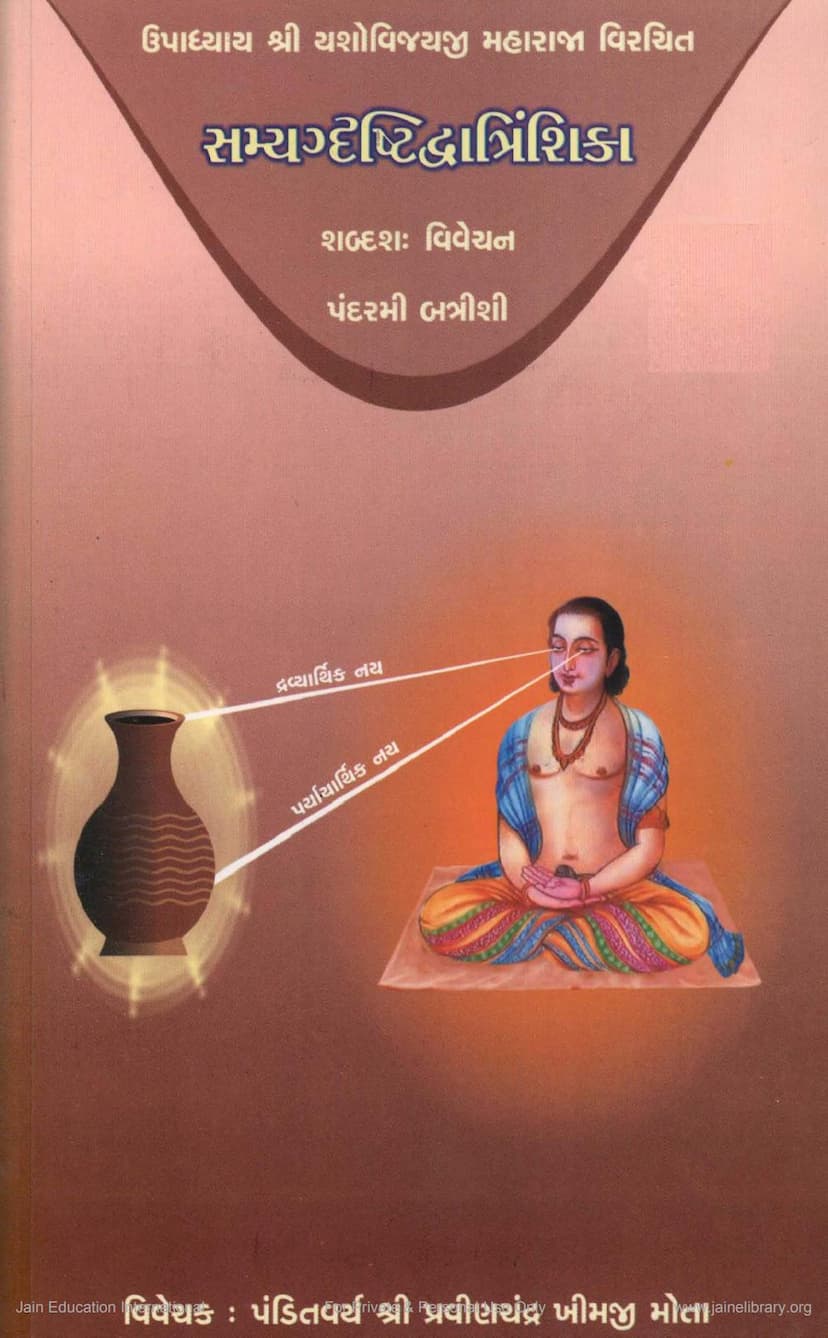Samyagadrushti Dvantrinshika
Added to library: September 2, 2025

Summary
The provided text is a Gujarati commentary on the "Samyagdrushti Dvātrinshikā" (Twenty-Two Verse Treatise on Right Faith) by the esteemed Jain scholar Acharya Yashovijayji Maharaj, with commentary by Pandit Pravinchandra Khimji Mota. The book, published by Gitarth Ganga, is part of a larger series of commentaries on classical Jain scriptures.
Here's a summary of the key themes and content based on the provided pages:
Core Subject: Samyagdrushti Dvātrinshikā
- Author and Commentary: The original work is by Mahamahopadhyaya Shrimad Yashovijayji Maharaj, a highly respected scholar known for his extensive and precise literary contributions to Jain philosophy. The commentary is by Pandit Varay Shrimad Pravinchandji Khimji Mota.
- Placement within a Larger Work: The "Samyagdrushti Dvātrinshikā" is identified as the 15th chapter within Yashovijayji Maharaj's magnum opus, the "Dvātrinshat-Dvatrinshikā" (Thirty-Two Treatises, each of Thirty-Two Verses). This larger work is considered a masterpiece of Jain scholarship.
- Central Theme: The Nature of a Samyagdrushti (Right-Faithful Person): The treatise aims to describe the characteristics and state of a soul that has attained Samyagdarshan (Right Faith).
- Attainment of Samyagdarshan: It explains that souls who are apunarbhandhak (not bound to cycle of rebirth) and whose karmic obstructions (kashayas) have subsided through virtuous conduct and right understanding gradually attain Samyagdarshan.
Key Concepts Discussed in the Commentary:
-
Three Marks (Linga) of a Samyagdrushti:
- Shushrusha (Eagerness to Listen): A Samyagdrushti possesses an intense desire to hear and understand the teachings of the Tirthankaras, surpassing the pleasure derived from worldly enjoyments or even artistic performances. This desire stems from the understanding that the knowledge gained from these teachings leads to eternal bliss and is the means to escape the cycle of suffering.
- Dharmaraga (Devotion to Righteousness/Virtue): The Samyagdrushti has a profound inclination towards righteous conduct and the practice of virtues (like equanimity and self-control). While they may still engage in worldly activities due to past karma, their inner inclination is towards spiritual growth.
- Guru-Devadi Puja (Worship of the Guru, Devas, etc.): A Samyagdrushti reveres their spiritual preceptors (Gurus) and the enlightened beings (Devas) who guide the path to liberation. This devotion is not mere outward ritual but a sincere and profound reverence, performed with their full capacity, aimed at accumulating strength for spiritual practice.
-
The Process of Attaining Samyagdarshan: The Three Karanas (Processes):
- Yathāpravrttikarana: A process that occurs without conscious intent, like a round stone rolling down a riverbed. This is an initial stage of purification.
- Apūrvakaraṇa: A completely unprecedented and unique inner transformation or state of consciousness, never experienced before.
- Anivartikarana: An irrevocable process that continues until Samyagdarshan is attained, characterized by perfect equanimity and the ability to discern truth from falsehood. The text explains how these stages, particularly Apūrvakaraṇa and Anivartikarana, are crucial for breaking the karmic knot (granthi) that obscures right faith.
-
The State of a Samyagdrushti after Falling from Grace:
- Even if a Samyagdrushti falls from their state due to strong passions or external influences, they do not create the same level of severe karma as a deluded soul (mithyādrushti). Their past karmic state limits the intensity of new bondages, meaning they won't bind as much new, potent karma, and their residual good inclinations remain. This is likened to stepping on a red-hot iron – one tries to minimize contact and withdraw as quickly as possible.
-
Comparison with Bodhisattvas (Buddhist Concept):
- The commentary draws parallels between the characteristics of a Samyagdrushti and the concept of a Bodhisattva as understood in Buddhism. It highlights similarities in their altruistic tendencies (parārtharāg, mahāśay), wisdom (dhīmān), progress on the path (mārgamī), and virtue (guṇarāgī).
- The text delves into the etymological meaning of "Bodhisattva" – one who is primarily guided by bodhi (right understanding) or one who is destined to become a Tirthankara. This comparison is used to illustrate the elevated spiritual state of a Samyagdrushti.
-
The Nature of "Shishta" (The Virtuous/Learned):
- A significant portion of the text (from Shloka 17 onwards) critically examines the definition of "Shishta" as traditionally understood by Brahmins, which often centers on adherence to Vedic rituals and texts.
- The commentary meticulously analyzes and refutes various Brahminical definitions of "Shishta," pointing out their flaws such as ativyāpti (over-applicability) and avyāpti (under-applicability).
- It argues that true virtuous conduct and right understanding, as defined by Jain principles (like following the teachings of the Tirthankaras and discerning truth through right faith), are the true marks of a "Shishta." The debate highlights the philosophical differences in defining ultimate virtue and authority between Jain and Vedic traditions.
- The commentary emphasizes that the Jain definition of "Shishta" resides in one who possesses Samyagdarshan and its associated virtues, as opposed to mere adherence to external rituals or texts without true understanding.
Overall Purpose and Significance:
The "Samyagdrushti Dvātrinshikā," through its detailed commentary, aims to:
- Provide a profound understanding of the spiritual state of a soul that has attained Samyagdarshan.
- Explain the subtle marks and processes involved in this attainment.
- Distinguish the true nature of virtue and spiritual attainment from superficial adherence to rituals or beliefs.
- Underscore the superiority of Jain philosophy in defining true spiritual knowledge and conduct compared to other traditions, particularly in its nuanced understanding of "Shishta."
- Serve as a guide for spiritual aspirants seeking to cultivate right faith and progress on the path to liberation.
The commentary, by Pandit Pravinchandji Mota, is noted for its clarity and ability to elucidate the complex philosophical points raised by Acharya Yashovijayji Maharaj. The publication is dedicated to making these profound spiritual teachings accessible to the Jain community.